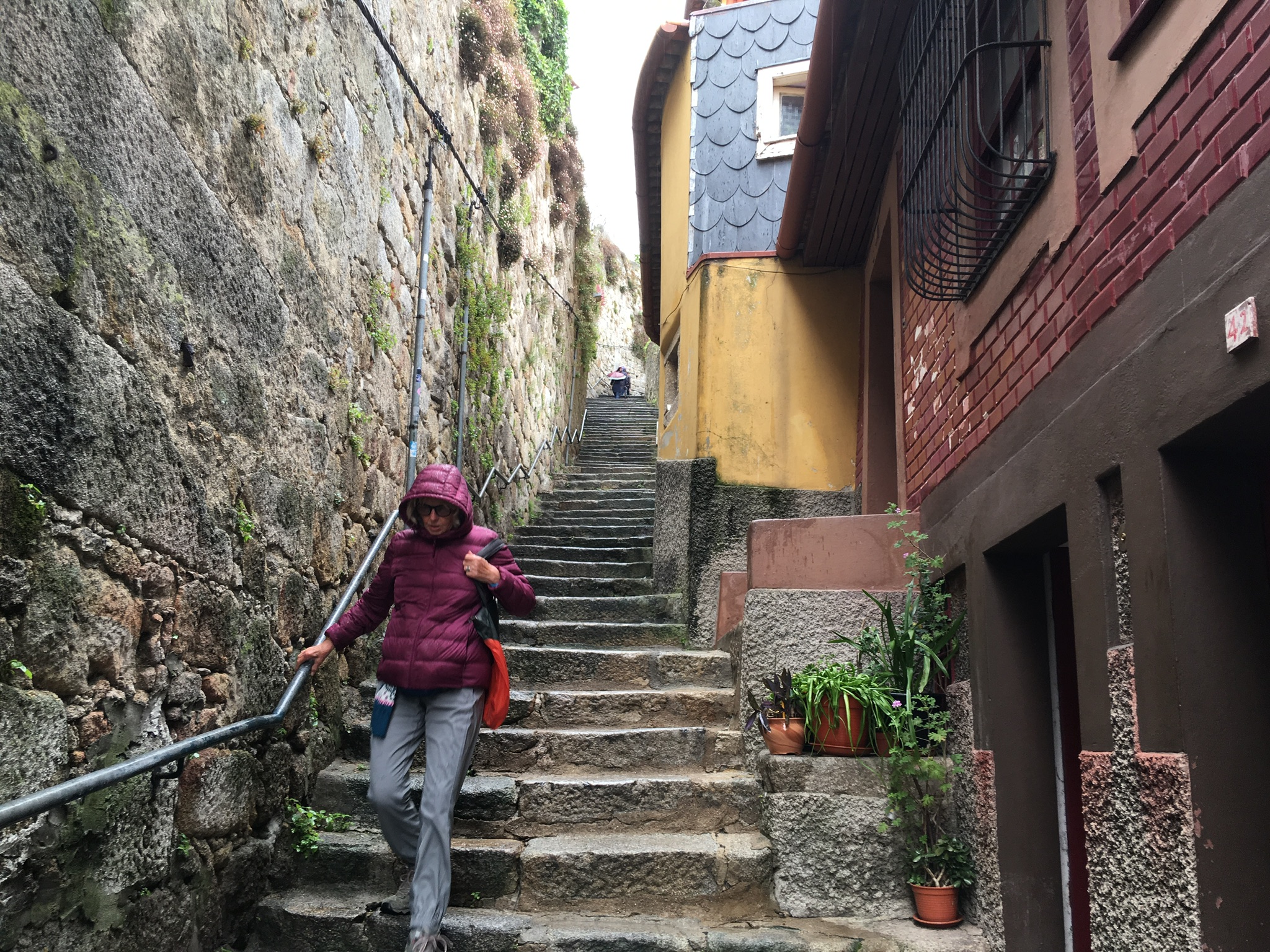The streets of Porto were washed for us once again as we searched for a special cafe. We walked in and out of our first one, but soon returned after failing to find a decent croissant in another. The barista in the ‘rejected cafe’ seemed to be waiting for us, as he gave us a ‘what took you so long’ look. Corrie was also getting her share of rejections. After getting into trouble asking for coffee in Spanish last week, she learnt it in Portuguese, and asked him for a ‘cafe com leite’. “Sorry we don’t have omelettes”, he said in perfect English.
I’ve seen the sit or stand cafes, but this was something else. There was: 1) standing at the bar – ‘no time to wait coffee’; 2) sitting at the bar – ‘can’t stand but no time’ 3) sitting at a table alongside the first two – ‘wanting a relaxed coffee’; and 4) tables and chairs down the back – ‘settling in with luggage, snacks and ipad coffee’. We chose (3) because we wanted to relax and they had no omelettes.
There was time left in the day however for more cultural pursuits. As we tried to keep on the right side, dodging people lightly washing their umbrellas, we had our camino passports stamped at the Cathedral, a necessity if you want pilgrim privileges along the way. This done, we had a short walk through the cathedral, with the highlight being some delightful paintings on the ceiling of the notary chamber.
From here we continued our cobblestone slide to the home of Guerra Junqueiro, one of Europe’s greatest poets. His poetry was highly satiric and he used this medium, backed by his journalistic background and his time as a member of the lower house, to criticise conservatism, the Catholic church and the Portuguese monarchy contributing greatly to the Portuguese Revolution of 1910.
Back on the narrow winding streets that were getting older, as we stepped carefully down past Porto’s oldest house built in the 13th century and eventually reaching the shores of the wonderful Douru river. The rivers of rainfall today join the waters from the Spanish mountains to form this superb waterway that creates a natural border between Spain and Portugal for over 100 kms, eventually becoming the spectacle that is the Douro Valley.
We retrace our steps back up the steep hillside of Porto finding now even more cobbled streets with their ancient walls framing their now modern interiors. There is no time left to visit my Porto bookshop which I am sure would have had a lot more to add to my short story, but there will be time to pursue this in another town somewhere on the Iberian peninsular.


Hi Will & Corrie, Good Friday here & so with no plans a delicious long lie in to catch up with your beautiful blog & spend lots of time on Gougle maps, pretending we are with you. Such wonderful word pictures Will together with your pics brings it all to life.
Sending big hugs Pete & Li
Thanks Li
Sorry I missed this earlier, enjoy your commentsb.
Many hugs from us both
Will
Enjoying the cafe yarns, guys! Hearing about the cathedral takes my mind to Notre Dame – and how amazing structures I assume to be there for all time also have a life and ending:recreating.
Wishing you ease and lightness of spirit as you take the next path from Porto.
Thank you Anne,
I’ll carry them both with great respec
Hello again dearest friends
Just caught up with your blogs for the last five days, savouring the various experiences along the way. Things that stood out for me
Day 10: wonderful writing and great metaphors. An ancient castle, with lots of character, but no longer useful/needed – probably how many ‘ancient’ people feel; and a ‘dead’ tree with new saplings growing out of it, which could link to the previous point – the challenge for us senior citizens to not feel dead, and to find new growth in possibly unlikely places.
Day 11: The Knights Templar brought back childhood memories with those wonderful stories. Great to hear you say you had a relaxing and cherishing time with dear friends. One comment of your reminded me of John Lennon having said, “Life is what happens to you while you’re making other plans.” You seem to have adapted well to your body’s limitations, Will, and made the most of the situation (as you always do).
Day 12: Those poppies!!
Day 13: All those aps that are available for anything and everything – quite amazing. That was the most beautiful photo of a bank that I have ever seen!
Day 14: I’ve never heard of ‘sit or stand’ cafes, with all their options, or of the great poet Guerra Junqueiro. I must look him up.
Safe and pleasurable travelling, dearest ones. We’re with you in spirit.
Narayan and Janine
Lovely Narayan, thank you for your keen summary and the time you take
Will
Great to see your face next to the text. The photos are very good, as others have observed. By my count there are 16 cities named Santarem in Portugal and you and Corrie visited most of them (HI Corrie, Kathi sends her love)
Is Porto also a multiple city? If so, get a bottle of port in each one and do some serious taste testing. The weather here is great, We miss you in Sydney and look fwd to your stories upon your return.
Love from us both, Kathi and Mike
Good to hear from you Mike. No,
I’ve googled both and only one of each